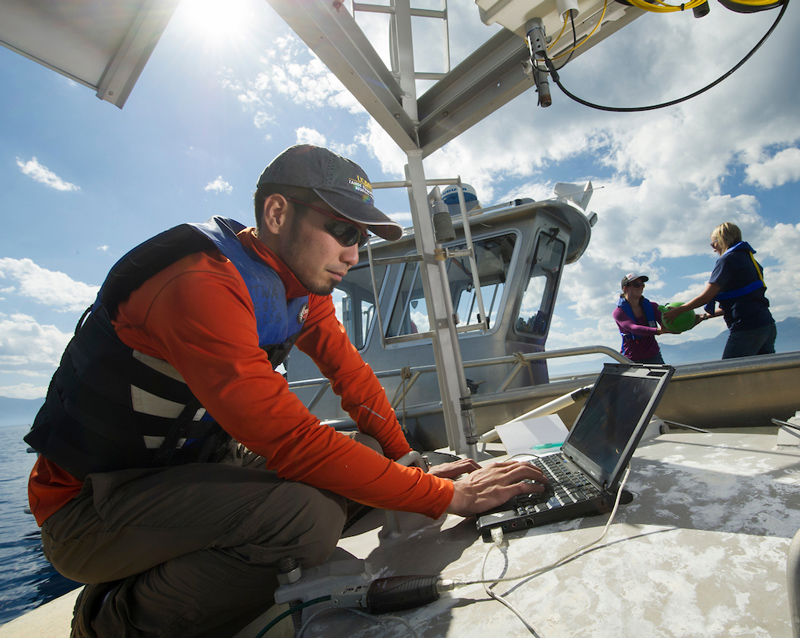Lake Tahoe’s sparkling, clear water is a point of pride among locals and a draw for tourists. Although the water clarity—measured by how deep visible light can penetrate—has decreased since measurements began in 1968, conservation efforts over the past 2 decades have stabilized it.
However, a new study published last month in Limnology and Oceanography Letters shows that ultraviolet (UV) light tells a different story. The depths to which UV radiation reaches in Lake Tahoe vary dramatically between extreme wet and dry years. Because UV radiation can affect chemical and biological processes, shifting underwater light environments between years could have significant implications for Lake Tahoe’s ecosystem.
A Question of Clarity
To measure water clarity in Lake Tahoe, a 1,645-foot-deep (594-meter-deep) freshwater lake straddling the border of California and Nevada in the Sierra Nevada Mountains, scientists drop a white disk into the water and record how deep they can see it. They use a similar approach to measure UV light, but because it’s invisible to our eyes, they drop a sensor that measures different wavelengths of UV light as it sinks.
Eighteen years ago, scientists at the University of California, Davis Tahoe Environmental Research Center began collecting UV data from the lake every 2 to 3 weeks, creating a long-term record rare for lakes anywhere in the world.
“You can use satellites to look at long-term trends in water clarity, and people have done that all over the U.S. and around the world,” said Kevin Rose, a freshwater ecologist at Rensselaer Polytechnic Institute in New York, but “a multidecade record of UV radiation is a unique asset.” Rose was not involved in the study.
“We found a huge fluctuation in UV transparency year to year.”
Several studies have used data from the record, but limnologist Shohei Watanabe at the Tahoe Environmental Research Center and his colleagues wanted to do a comprehensive analysis of whether Lake Tahoe was experiencing changes in the penetration of UV light between 2006 and 2023.
Watanabe initially expected to see a gradual decrease in UV penetration over the study period, mirroring the trend in visible light. “Instead, we found a huge fluctuation in UV transparency year to year,” he said.
In drought years, such as 2014–2015, UV radiation penetrated deeper than in exceptionally wet years such as 2017, when the Sierra Nevada received its second-highest amount of precipitation since 1910.
“It’s an amazing difference,” Watanabe said. The most dramatic differences occurred during the spring and early summer, when solar radiation is at its strongest. UV radiation was 100 times stronger 10 meters (32 feet) below the surface and reached up to nearly 4 times deeper in summers during drought years.

The phenomenon occurs because wet years wash more particulates and dissolved organic matter off the slopes of the surrounding mountains and into the lake, which blocks the UV radiation.
Visible light showed only a twofold difference in how deep it penetrated the lake between wet and dry years because the longer wavelengths of visible light are not as easily blocked by dissolved organic matter in the water. To the naked eye, visitors might notice some changes in the water clarity between years, “but it’s not like a 100-fold difference,” Watanabe said.
A Sunburn on the Ecosystem
The balance of UV light and visible light is crucial in freshwater ecosystems. UV radiation breaks down dissolved organic matter, releasing carbon dioxide into the atmosphere. Just like UV light can give us a sunburn, it can harm freshwater organisms by damaging DNA and inhibiting photosynthesis. It can also affect zooplankton behavior—these organisms actively avoid harmful UV light by migrating deeper during the day.
For the most biologically damaging UV wavelengths, including 305 and 320 nanometers, the differences from year to year in Lake Tahoe were most pronounced.
UV radiation isn’t always harmful to the ecosystem, however. Rose noted previous research showing that it prevents invasive fish, such as bluegill, from successfully reproducing in Lake Tahoe’s clear waters because larvae don’t survive high UV exposure. The fish become restricted to murky nearshore areas such as marinas.
“I really want to stress the importance of long-term monitoring for this kind of environmental study.”
Drastic shifts in UV penetration between wet and dry years therefore imply big changes in the ecosystems in the lake—and those swings could get more intense with human-caused climate change. “When we think about Lake Tahoe, now, going through precipitation cycles, that also means potential biological damage,” Rose said. Fully understanding how these communities will react will require continued monitoring.
Similar UV cycles might also occur in other clear mountain lakes worldwide, but each lake system has unique characteristics that would influence light patterns. “I really want to stress the importance of long-term monitoring for this kind of environmental study,” Watanabe said.
Watanabe and his colleagues are now planning and performing studies to determine how these UV variations affect Lake Tahoe’s carbon cycle, primary productivity, and other biological processes. “That’s the next step,” he said.
—Andrew Chapman (@andrewchapman.bsky.social), Science Writer

